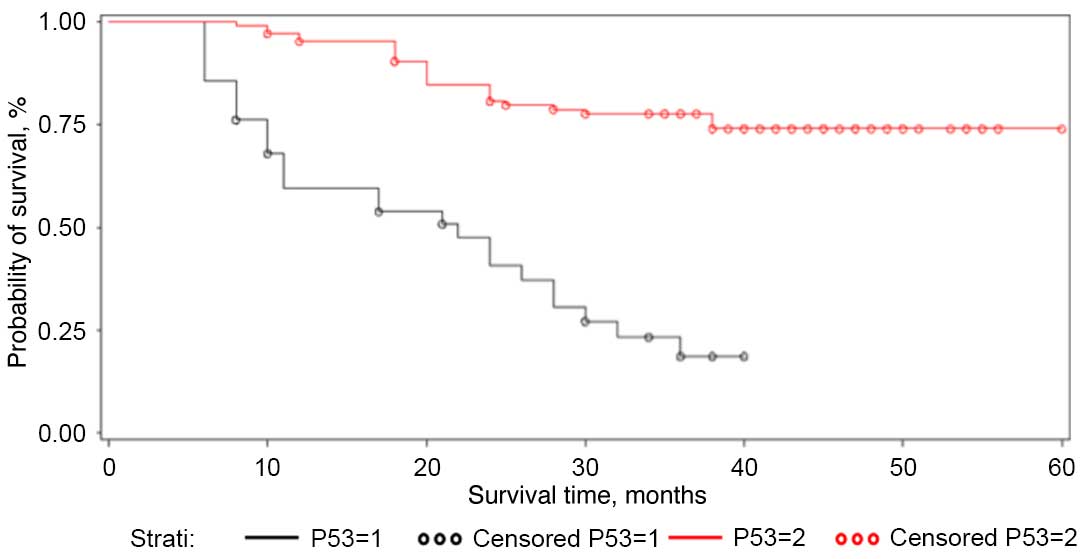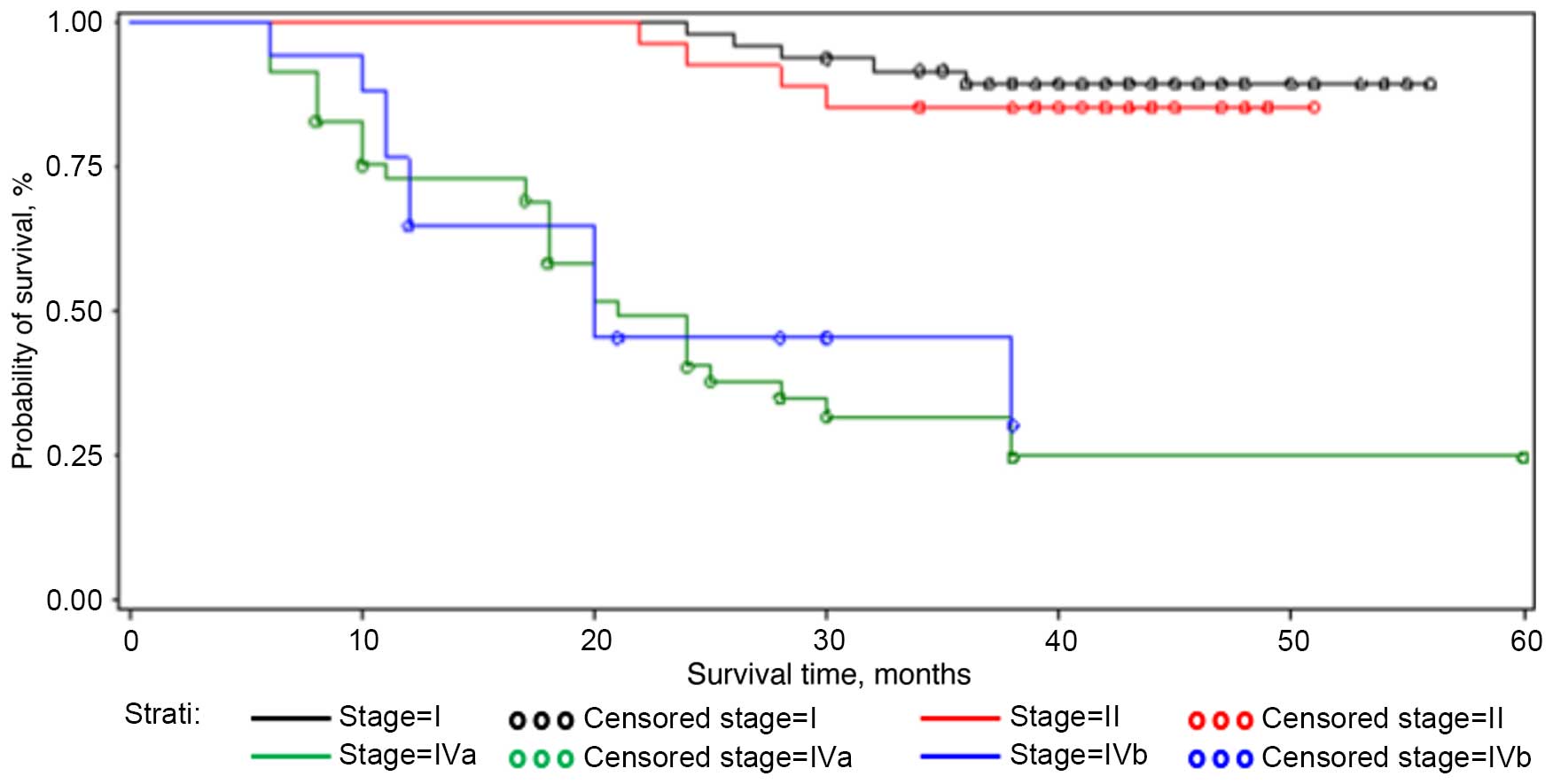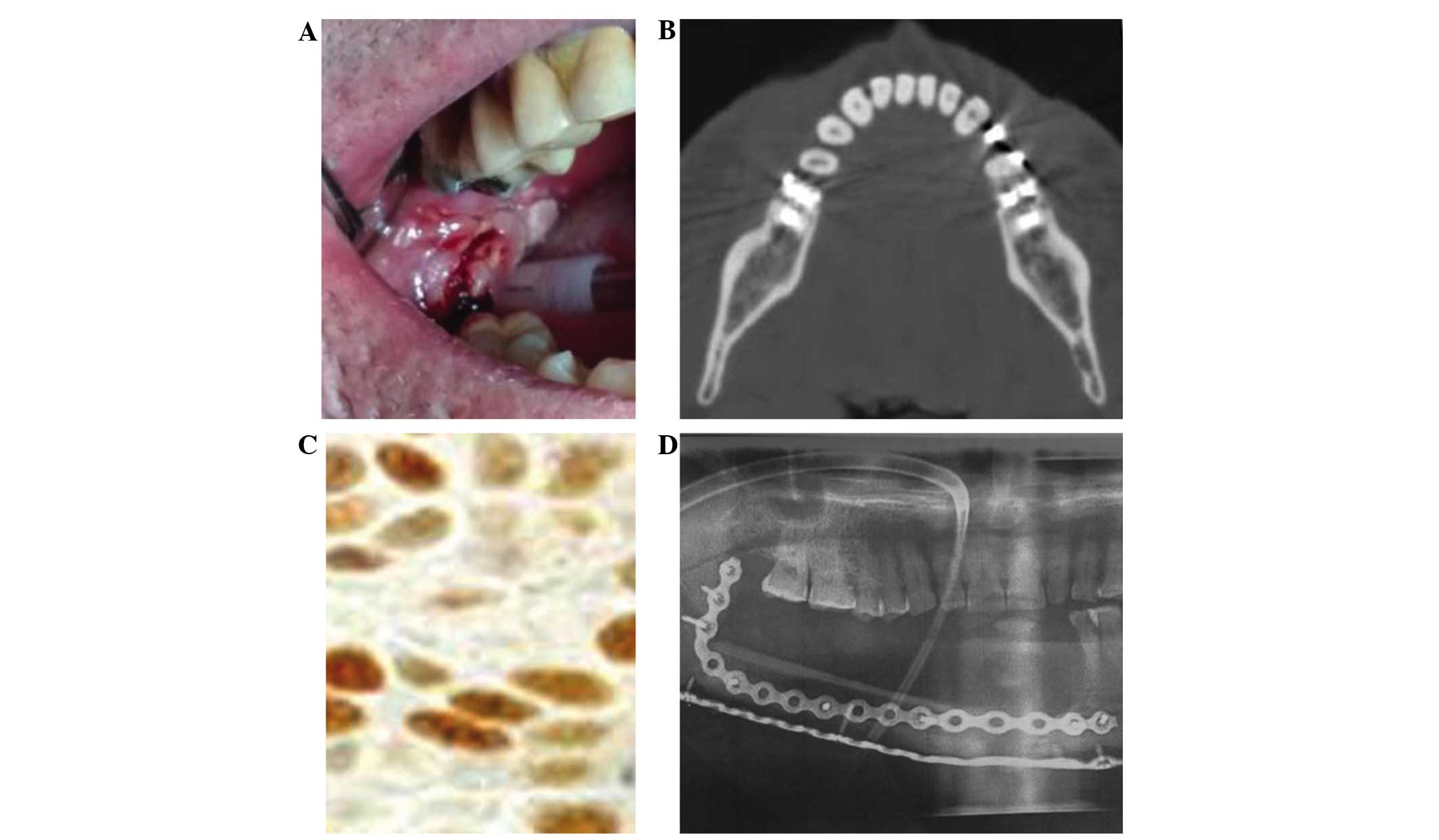|
1
|
Durmus K, Apuhan T and Ozer E: Transoral
robotic surgery for retromolar trigone tumours. Acta
Otorhinolaryngol Ital. 33:425–427. 2013.PubMed/NCBI
|
|
2
|
Freudlsperger C, Bodem JP, Engel E and
Hoffmann J: Mandibular reconstruction with a prefabricated free
vascularized fibula and implant-supported prosthesis based on fully
three-dimensional virtual planning. J Craniofac Surg. 25:980–982.
2014. View Article : Google Scholar : PubMed/NCBI
|
|
3
|
Bànkfalvi A and Piffkò J: Prognostic and
predictive factors in oral cancer: The role of the invasive tumor
front. J Oral Pahol Med. 29:291–298. 2000. View Article : Google Scholar
|
|
4
|
Jan JC, Hsu WH, Liu SA, Wong YK, Poon CK,
Jiang RS, Jan JS and Chen IF: Prognostic factors in patients with
buccal squamous cell carcinoma: 10-year experience. J Oral
Maxillofac Surg. 69:396–404. 2011. View Article : Google Scholar : PubMed/NCBI
|
|
5
|
Liao CT, Huang SF, Chen IH, Kang CJ, Lin
CY, Fan KH, Wang HM, Ng SH, Hsueh C, Lee LY, et al: Outcome
analysis of patients with pN2 oral cavity cancer. Ann Surg Oncol.
17:1118–1126. 2010. View Article : Google Scholar : PubMed/NCBI
|
|
6
|
Holmes JD, Martin RA and Gutta R:
Characteristics of head and neck cancer patients referred to an
oral and maxillofacial surgeon in the United States for management.
J Oral Maxillofac Surg. 68:555–561. 2010. View Article : Google Scholar : PubMed/NCBI
|
|
7
|
Pérez-Sayáns M, Somoza-Martín JM,
Barros-Angueira F, Reboiras-López MD, Gándara Rey JM and
García-García A: Genetic and molecular alterations associated with
oral squamous cell cancer (Review). Oncol Rep. 22:1277–1282. 2009.
View Article : Google Scholar : PubMed/NCBI
|
|
8
|
Schwartz JL: Biomarkers and molecular
epidemiology and chemoprevention of oral carcinogenesis. Crit Rev
Oral Biol Med. 11:92–122. 2000. View Article : Google Scholar : PubMed/NCBI
|
|
9
|
Shah NG, Trivedi TI, Tankshali RA, Goswami
JA, Shah JS, Jetly DH, Kobawala TP, Patel KC, Shukla SN, Shah PM
and Verma RJ: Molecular alterations in oral carcinogenesis:
Significant risk predictors in malignant transformation and tumor
progression. Int J Biol Markers. 22:132–143. 2007.PubMed/NCBI
|
|
10
|
Shah NG, Trivedi TI, Tankshali RA, Goswami
JV, Jetly DH, Shukla SN, Shah PM and Verma RJ: Prognostic
significance of molecular markers in oral squamous cell carcinoma:
A multivariate analysis. Head Neck. 31:1544–1556. 2009. View Article : Google Scholar : PubMed/NCBI
|
|
11
|
Shillitoe EJ, May M, Tale V, Lethanakul C,
Enseley JF, Strausberg RL and Gutkind JS: Genome-wide analysis of
oral cancer-early results from the cancer genome anaromy project.
Oral Oncol. 36:8–16. 2000. View Article : Google Scholar : PubMed/NCBI
|
|
12
|
Murugan AK, Munirajan AK and Tsuchida N:
Ras oncogenes in oral cancer: The past 20 years. Oral Oncol.
48:383–392. 2012. View Article : Google Scholar : PubMed/NCBI
|
|
13
|
Saito T, Nakajima T and Mogi K:
Immunohistochemical analysis of cell cycle-associated proteins p16,
pRb, p53, p27 and Ki-67 in oral cancer and precancer with special
reference to verrucous carcinoma. J Oral Pathol Med. 28:226–232.
1999. View Article : Google Scholar : PubMed/NCBI
|
|
14
|
Sidransky D, Boyle J and Koch W: Molecular
screening. Prospects for a new approach. Arch Otolaryngol Head Neck
Surg. 119:1187–1190. 1993. View Article : Google Scholar : PubMed/NCBI
|
|
15
|
Boyle JO, Hakim J, Koch W, van der Riet P,
Hruban RH, Roa RA, Correo R, Eby YJ, Ruppert JM and Sidransky D:
The incidence of p53 mutations increases with progression of head
and neck cancer. Cancer Res. 53:4477–4480. 1993.PubMed/NCBI
|
|
16
|
Jones A: A general review of the p53 gene
and oral squamous cell carcinoma. Ann R Australas Coll Dent Surg.
14:66–69. 1998.PubMed/NCBI
|
|
17
|
Nylander K, Dabelsteen E and Hall PA: The
p53 role molecule and its prognostic role in squamous cell
carcimonas of the head and neck. J Oral Pathol Med. 29:413–425.
2000. View Article : Google Scholar : PubMed/NCBI
|
|
18
|
Tandon S, Tudur-Smith C, Riley RD, Boyd MT
and Jones TM: A systematic review of p53 as a prognostic factor of
survival in squamous cell carcinoma of the four main anatomical
subsites of the head and neck. Cancer Epidemiol Biomarkers Prev.
19:574–587. 2010. View Article : Google Scholar : PubMed/NCBI
|
|
19
|
Cutilli T, Papola F and Corbacelli A: p53
overexpression and mutation, chemoresistance and patient survival
in oral and maxillofacial squamous carcinoma. J Chemother.
9:123–124. 1997. View Article : Google Scholar : PubMed/NCBI
|
|
20
|
Cutilli T, Papola F, Di Emidio P and
Corbacelli A: p53 tumor suppressor protein and H-RAS oncogene in
maxillofacial tumors: Immunohistochemical and genetic investigaion,
induction chemotherapy response and prognosis evaluation. J
Chemother. 10:411–417. 1998. View Article : Google Scholar : PubMed/NCBI
|
|
21
|
Cutilli T, Leocata P, Dolo V and Altobelli
E: Evaluation of p53 protein as a prognostic factor for oral cancer
surgery. Br J Oral Maxillofac Surg. 51:922–927. 2013. View Article : Google Scholar : PubMed/NCBI
|
|
22
|
Green FL, Page DL, Fleming ID, Fritz AG,
Balch CM, Haller DG and Morrow M: AJCC cancer staging manual. 6th.
Springer; New York: 2002, View Article : Google Scholar
|
|
23
|
World Health Organization = IARC
monographs on the evaluation of carcinogenic risks to humans:
Biological Agents. 100B. A review of human carcinogens.
International Agency for Research on Cancer; Lyon: 2012
|
|
24
|
Greene FL, Page DL, Fleming ID, Fritz AG,
Balch CM, Haller DG and Morrow M: AJCC Cancer Staging Manual. 6th.
Springer-Verlag; New York, NY: 2002, View Article : Google Scholar
|
|
25
|
Specenier P and Vermorken JB: Advances in
the systemic treatment of head and neck cancers. Curr Opin Oncol.
22:200–205. 2010. View Article : Google Scholar : PubMed/NCBI
|
|
26
|
Jenwitheesuk K, Surakunprapha P, Chowchuen
B, Tangvoraphongchai V, Pesee M, Krusun S and Supaadirek C: Results
of multidisciplinary therapy of squamous cell carcinoma of the
buccal mucosa at Srinagarind Hospital, Thailand. J Med Assoc Thai.
93:1262–1267. 2010.PubMed/NCBI
|
|
27
|
Hakeem AH, Pradhan SA, Tubachi J and
Kannan R: Outcome of per oral wide excision of T1-2 N0 localized
squamous cell cancer of the buccal mucosa-analysis of 156 cases.
Laryngoscope. 123:177–180. 2013. View Article : Google Scholar : PubMed/NCBI
|












